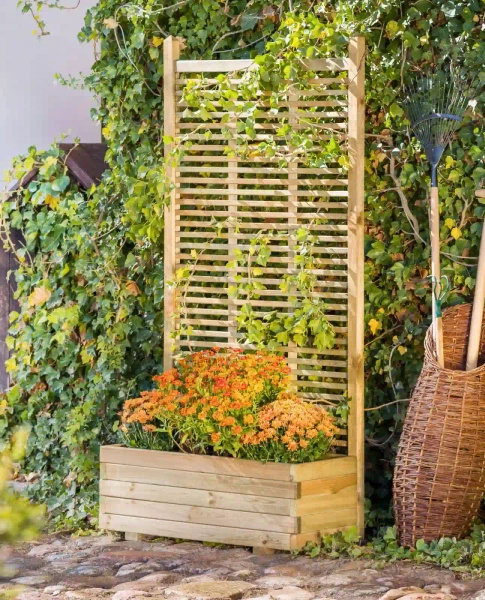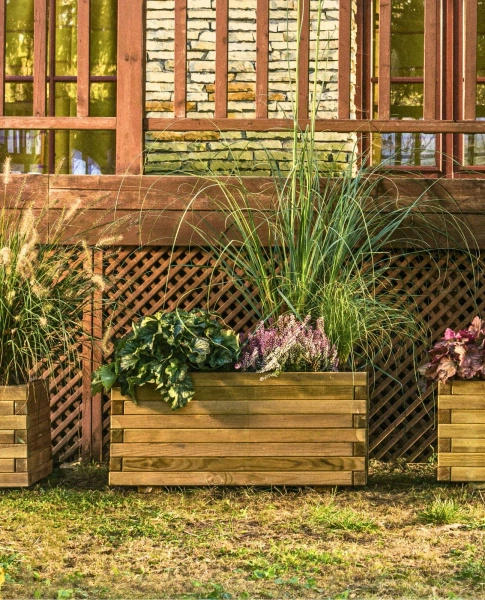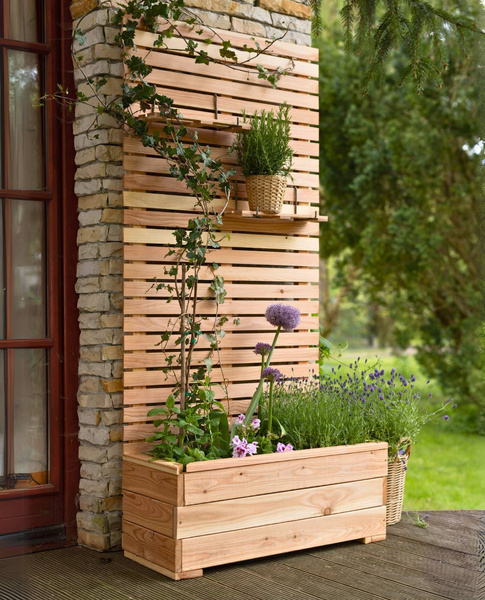What should you know about wooden pots and how to maintain them?

Durability
The wood from which the pots are made is the healthiest material for the plants planted in them! Due to its porosity, wood ensures good gas exchange in the substrate. It also has low thermal conductivity, which means that the pots made from wood do not heat up much in summer and protect the root system from drastic temperature drops in winter. If the temperature falls below -25-30°C, even pots with walls lined with an additional 2 cm layer of polystyrene do not guarantee sufficient protection for frost-sensitive plants such as clematis, rhododendrons or roses. The great advantage of wooden garden pots is their aesthetic value. Wood blends in beautifully with plants and looks very natural. The price is also important. Wooden pots are much cheaper than ceramic or stoneware pots of the same size and with large dimensions also than plastic or conglomerate. However, it should be noted that wood is not as durable as plastic or ceramic.
How do I care for pots so that they retain their beautiful look and fulfil their role for as long as possible?
The bottom of the wooden pot is the least durable. Water leaks through the holes at the bottom of the pot, so the wood is constantly wet there and therefore this part is most susceptible to rotting. To reduce the pot's contact with the soil, it is best to insulate the wood by lining the inside of the pot with normal construction foil or thick garden fleece. Of course, holes should be made in the foil at the bottom of the pot to allow excess water to drain away. Damage to the soil can also be prevented by using feet, e.g. with Jagram planters. Thanks to them, a free space is created between the bottom and the soil, through which the water under the pot can drain freely. To make the products more durable, the wood from which Jagram products are made is subjected to pressure and vacuum impregnation. This process is carried out using a specially developed device - an autoclave. In the autoclave, impregnating agents, fungicides and insecticides are forced into the wood under pressure. Thanks to the considerable pressure and the vacuum created earlier, the impregnation penetrates much deeper into the wood structure than when immersed in an impregnating solution or paint. This method considerably extends the durability of the wood. It is best to install wooden garden accessories so that they do not come into contact with the ground, as the wood absorbs water from damp soil. You can install elements (pergolas, trellises, etc.) with steel anchors or on concrete blocks (e.g. gazebos). The durability of such insulated wood increases to 15 years. Pots are a specific product as they cannot be completely insulated from the ground. Even with the use of foil, we can only achieve 5-10 years of rot resistance. After this time, the base plates must be reinforced or completely replaced. The durability of the structure of wooden garden pots over several years is completely sufficient, as the plant arrangement in the pot must then also be replanted. The composition must be refreshed and the soil replaced, as the substrate in pots and containers becomes salty after several years of fertilisation and no longer supports the good development of the plants. It can cause a ‘physiological drought’, in extreme cases it can stop growth completely and even lead to the death of the plants.
How big should a wooden pot be?
The best pot is one that does not exceed 80-100 centimetres. The longer the side, the longer the elements that make up the walls of the pot, and they deform more easily under the influence of earth pressure, which freezes in winter. Over time, this can lead to the complete destruction of the structure. In addition, large pots filled with soil are very heavy and cannot be placed anywhere. For example, they can pose a threat to the balcony (100 litres of moist potting soil weigh around 170 kg). On the other hand, the considerable weight of the pot filled with soil can be very useful if we treat it as a stable base for the pergola we want to build on the balcony or terrace. By screwing the posts and grids to the sides of the pots, we can easily create a spatial arrangement that we can additionally change after some time by rearranging the pots. To make this possible, the containers should not be too heavy, so it is worth using pots with a capacity of 100 to 150 litres, i.e. about 80 to 100 centimetres long and 40 to 50 centimetres wide. When calculating the volume of the pot, remember to subtract the thickness of the wooden walls, which is usually 4 to 5 centimetres We recommend creating arrangements with wooden pots that will be an elegant decoration.




